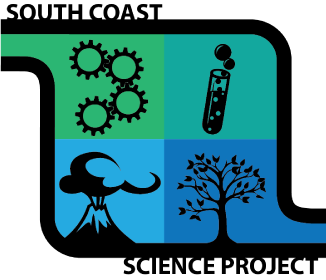The 2022 SCSP Summer Institute focused on Physics (PS2, PS3, & PS4). The content of this institute will be repeated in 2028.
The 2023 SCSP Summer Institute focused on Chemistry and Engineering (PS1 & ETS1). The content of this institute will be repeated in 2029.
PS1: Chemistry: Matter and Its Interactions Lessons
Conceptual Flow: Chemistry: Matter and Its Interactions
PS2: Motion and Stability: Forces and Interactions Lessons
Conceptual Flow: Forces and Motion
Conceptual Flow: Waves and Energy
PS4: Waves and Their Applications for Information Transfer Lessons
Conceptual Flow: Waves and Energy
Conceptual Flows: Physical Science
Our conceptual flows are diagrams that show one way that scientific concepts within a specific disciplinary core idea can connect and build. These diagrams include concepts from kindergarten through eighth grade and help guide our instruction for each Summer Institute.
Conceptual Flow Diagram |
Disciplinary Core Ideas |
NGSS Performance ExpectationsClick on linked PEs to see corresponding lessons. |
Year Presented |
|
PS1: Matter and Its Interactions
|
2-PS1-1, 2-PS1-2, 2-PS1-3, 2-PS1-4 5-PS1-1, 5-PS1-2, 5-PS1-3, 5-PS1-4 7th and 8th Grade PEs: MS-PS1-1, MS-PS1-2, MS-PS1-3, MS-PS1-4, MS-PS1-5, MS-PS1-6 |
Chemistry & Engineering Summer 2023 |
|
|
PS2: Motion and Stability: Forces and Interactions
|
K-PS2-1, K-PS2-2 3-PS2-1, 3-PS2-2, 3-PS2-3, 3-PS2-4 |
Physics Summer 2022 |
|
|
PS2: Motion and Stability: Forces and Interactions
PS3: Energy
PS4: Waves and Their Applications for Information Transfer
|
1-PS4-1,1-PS4-2,1-PS4-3,1-PS4-4 4-PS3-1, 4-PS3-2, 4-PS3-3, 4-PS3-4, 4-PS4-1, 4-PS4-2, 5-PS3-1 |
Physics Summer 2022 |
Lessons: PS1 - Matter and its Interactions
Lessons: PS2 - Motion and Stability: Forces and Interactions
Grade Level |
NGSS Performance Expectation(s) |
Lesson Title and Description |
Lesson Materials |
Presenter(s) |
|
K-PS2-1 |
I Like to Move it, Move it This lesson is a TK lesson that is designed to prepare students for the Kindergarten PE K-PS2-1. It will focus only on a portion of this PE (speed of objects). This lesson introduces and differentiates between a push and pull on an object and how changing variables affect the speed of an object. Students will apply what they learned to Marble Run structures and will discuss the structure and function of different specialty pieces. They will predict how the pieces will affect marble motion (slow down or speed up the marble relative to a reference piece). After testing the effects of single pieces, they will predict and rank the order in which a marble will run fastest through five structures with five specialty pieces each. The activity ends with students building Marble Run structures, describing how the speed of a marble will change as it is going through their structures, then releasing a marble through their structure to confirm their ideas. |
Darby Feldiwnn Summer 2022 |
||
| 3-PS2-1 |
May the Force Be With You In this lesson, students will be introduced to balanced and unbalanced forces, and will learn how to draw simple force diagrams. Students will learn that friction is the contact force that counteracts a push or a pull. Students will apply these concepts to what happens when a toy car slides across rough and smooth surfaces. To analyze their data, students will find median distances, find ranges of medians, and make graphs. *Classroom Tested by 2021 Lesson Study Participant* "May the Force Be With You! Such a great opportunity to develop a strong understanding of pushes and pulls and balanced and unbalanced forces. With hands-on opportunities to push the cars, students all on their own were able to connect previous knowledge and verbalize the role friction plays in slowing an object. Students were provided with an opportunity to find the range and median values to analyze data. The students were very successful with these aspects of the data set as these were part of previous Sci Trek lessons. However, this could easily be used as an introduction to those concepts as well. The connection to energy and the transfer of energy was more of a challenge for the students, but the opportunity to begin to develop this concept through application and discussion is provided... All in all a fun, force filled activity!" - Allison Heiduk, Monte Vista Elementary |
Darby Feldwinn Sammi Lambert Summer 2022 |
||
|
5-PS2-1 |
Drop it Like its Hot In this lesson, students explore object motion using video, timers, and penpal data from other areas. With guidance, students use a time scale to compare data to be able to come to conclusions. Students will then create videos to communicate what they have learned. |
Kyla Rightmer Summer 2022 |

